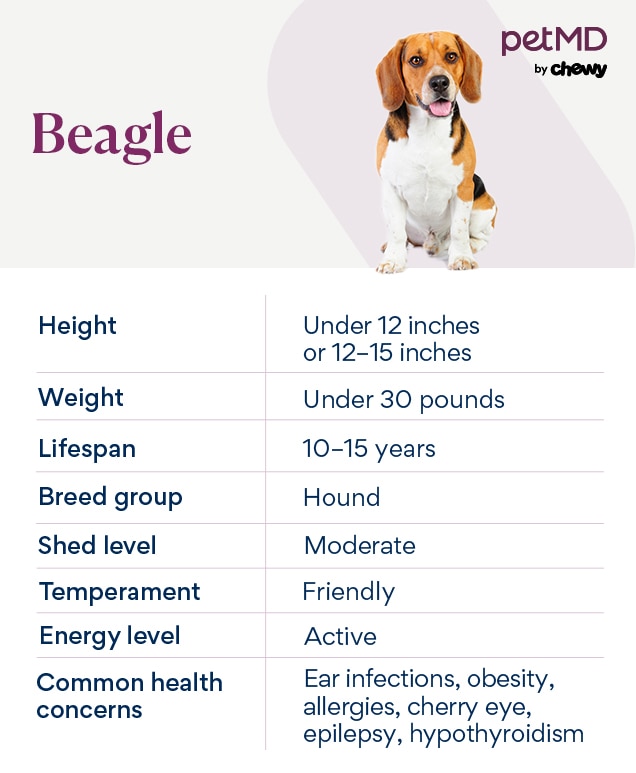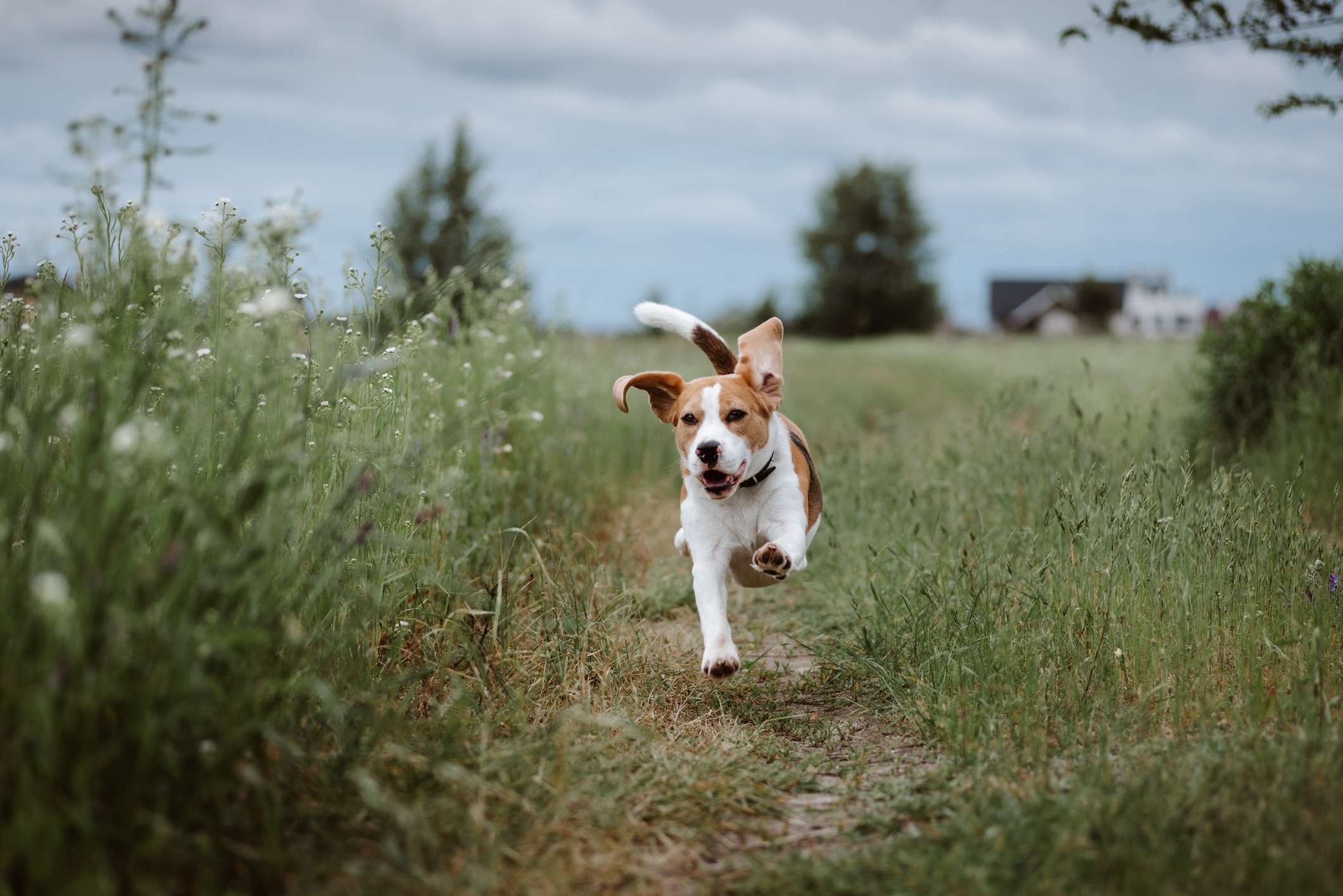Beagle
iStock/Maria Levkina
Beagles are generally considered to be medium-sized dogs, but they actually come in two sizes: One standing 12–15 inches tall, and a more miniature Beagle size of under 12 inches. No matter their size, a full-grown Beagle’s weight shouldn’t exceed 30 pounds.
Beagles come in several colors, including lemon, red and white, and the more common tricolor of black, brown, and white. The dogs have a smooth, dense double coat, a tail that seemingly never stops wagging, and floppy ears.
Caring for a Beagle

Beagles make wonderful pets for families and active pet parents. But take note: They need a lot of activities and supervision, as they are prone to following their nose to trouble.
Along with caring for their mental well-being, Beagles need special attention paid to their physical health too. Their floppy ears make them more susceptible to ear infections, so pet parents need to clean their Beagle’s ears regularly.
Beagle dogs are also prone to obesity, so they need measured meals spaced at regular time intervals (free-feeding is not recommended).
Beagle Health Issues

The average Beagle lifespan is 10–15 years. But, like every dog, this breed can develop certain health issues as they age. Pet insurance may be a good investment for families looking to bring home a Beagle puppy.
Ear Infections
Beagles are beloved for their long, floppy ears, but those ears do require some extra care.
Because they cover the ear opening completely, there is reduced air flow in the ear canal. This creates a moist, dark environment that allows bacteria and yeast to grow. This can result in an ear infection.
Beagles with ear infections will scratch excessively at their ears. You might even notice a yeasty smell or waxy debris in the ear canal. To prevent this, regularly clean your dog’s ears with a good-quality ear cleanser. But even with regular cleaning, ear infections may still occur.
If your Beagle gets an ear infection, your vet may recommend topical and oral medications. Schedule a vet appointment if you notice your Beagle scratching at their ears.
Obesity
Despite being a high-energy breed, obesity is very common among Beagles.
Most Beagles have an insatiable appetite along with a very strong sense of smell. If allowed, most will overeat and seek out any food within reach.
Pet parents need to measure their Beagle’s food consumption carefully and keep any temptations out of reach. Your vet can help you figure out how much and how often to feed your Beagle dog or puppy.
It’s also not uncommon for Beagles to eat something they shouldn’t have. This is called pica and can result in:
If you suspect your Beagle has eaten something they shouldn’t have, contact your veterinarian immediately. This could be a serious medical situation.
Limber Tail Syndrome
Beagles have a long tail that seems to never stop wagging. As a result of wagging too much, Beagles can experience limber tail syndrome, also called swimmers' tail.
This is a temporary, acute condition that results in a strain in the muscles used to keep the tail upright, causing a limp and sore tail. Limber tail syndrome usually resolves with a day or two of rest, but it can require pain medication to make your dog comfortable.
Allergies
Beagles can be prone to environmental and food allergies and may start to scratch excessively. About 50% of their ear infections are caused by allergies.
If your Beagle experiences allergies, there are many treatments your veterinarian may recommend. Medicated shampoos, mousses, wipes, and sprays can be helpful for itchy skin and allergies.
Environmental/seasonal allergies can also benefit from oral medications prescribed by your vet, such as Apoquel® or Cytopoint®.
Cherry Eye
A prolapsed gland in the eye, commonly referred to as "cherry eye,” is common in Beagles. This condition happens when the tear gland is inflamed, becoming visible in the lower inner corner of the eye.
This condition is usually not painful, but it can lead to eye infections. Cherry eye can occur in one or both eyes. Some cases resolve on their own, but most require surgical correction.
Epilepsy
Beagles can be more prone to epilepsy, a seizure disorder, than other breeds. This commonly starts when a Beagle is 2 to 5 years old, and it sometimes requires anti-seizure medications to help control seizures.
Seizures in dogs can last about 30–60 seconds, but they can also be longer (five to 10 minutes or more), and can range from mild to severe. A mild seizure may include involuntary movements, such as your dog’s legs going stiff. Signs of a severe seizure can include:
-
Loss of consciousness
-
Urinating
-
Defecating
-
Thrashing
-
Involuntary body movements
If you suspect your Beagle had a seizure, call your veterinarian right away.
Hypothyroidism
Hypothyroidism is common among Beagles. This is a disease of the thyroid gland, which controls metabolism. In hypothyroidism, the thyroid gland doesn’t produce enough thyroid hormone, which can cause metabolic changes.
Beagles experiencing hypothyroidism may have skin and hair coat changes such as a coarse and dry coat, hair loss, or chronic ear infections. It can also cause weight gain, even if you aren’t feeding your Beagle more than usual.
Hypothyroidism can be easily controlled with daily medications under your vet’s guidance, and affected dogs can live long and happy lives with consistent treatment.
What To Feed a Beagle

As mentioned, Beagles love food and can be prone to obesity. Usually, a well-balanced commercial dog food used in accordance with the producers' instructions and regular exercise will keep your Beagle at a healthy weight. Look for a dog food that meets the standards set by the Association of American Feed Control Officials (AAFCO).
However, if your Beagle becomes overweight, your veterinarian may recommend a prescription restricted-calorie diet.
Some manufacturers make breed-specific food for Beagles as well. Ask your veterinarian about how to choose the best dog food.
How To Feed a Beagle
Beagles should be fed the amount recommended by the food manufacturer at regular time intervals, usually two to three times daily to keep their metabolism increased. Beagle dogs should not be allowed to graze on their food all day.
Beagle puppies need to eat more frequently than adult dogs (up to four meals per day) to prevent hypoglycemia. It’s important to feed your dog based on their life stage—puppies need puppy-formulated food, adults need adult-formulated food, and senior dogs need senior-formulated food.
Some Beagles will eat too quickly, resulting in choking or vomiting undigested food. To help a hungry Beagle slow down (and to keep them entertained), use a slow feeder bowl so they work for their food.
How Much Should You Feed a Beagle?
When feeding your Beagle, follow the manufacturer’s instructions on the food package. Every food has a different caloric value, so it’s important to follow the guidelines.
If you change brands or flavors, don't assume that your Beagle will get the same amount of food in their bowl.
Along with the packaging guidelines, it’s best to talk with your veterinarian. The specific amount you should feed your dog varies from Beagle to Beagle, depending on your pup’s health, lifestyle, and other factors.
Nutritional Tips for Beagles
Healthy dogs eating an AAFCO-compliant diet won’t need any supplementation, as they will be receiving all needed nutrients. However, depending on your Beagle’s health, your vet may recommend a dog supplement.
Beagles can also benefit from foods made for sensitive skin, which are usually high in omega-3 fatty acids and help reduce inflammation. And if your veterinarian suspects that your pup has food allergies, they may prescribe a prescription diet to help.
Behavior and Training Tips for Beagles
Beagle Personality and Temperament

Beagles make loving, affectionate pets that are generally good with children and other animals at home, according to the National Beagle Club of America (NBCA).
Most Beagle puppies are full of energy, but they tend to slow down as they age and become a bit lazier. That said, Beagles, full-grown or otherwise, still love joining their pet parents for walks, runs, or hikes. They need at least an hour of exercise every day.
Beagle puppies need to be socialized from an early age to grow into well-mannered and confident adults. Ask your vet for recommendations on how to safely and appropriately expose your puppy to new things.
Beagle Behavior
A Beagle’s temperament and behavior are influenced by their history as hunting dogs.
Led by their powerful nose, Beagles will unzip backpacks to steal lunches and counter-surf for snacks. Their sense of smell keeps their nose to the ground, and they will follow it to anything that smells curious to them.
Beagle pups are very curious—which means they can easily get into trouble and wander away if left unattended. When outside, they always need to be on a leash or inside a fenced-in yard so they don’t walk off in search of an interesting scent.
As hound dogs, Beagles are also known for their loud, long bark and howl. They will bark when confronted with new people and strange noises.
Beagle Training
Beagles are smart, but they but can also have a short attention span when it comes to training. Because they are food-motivated, most Beagles train best before mealtime and will do just about anything for treats.
That said, be mindful of how many treats you’re giving your cute Beagle. Treats should never make up more than 10% of a dog’s daily calories, and you can train your dog with positive reinforcement using praise and toys in place of snacks.
Potty training can be especially difficult with Beagles. Because of their powerful nose, they can easily smell where a part of the house was previously soiled and be prompted to pee there themself. Repetition, consistency, and positive reinforcement work best to help potty train Beagle puppies.
Their nose can also make leash training difficult because they are constantly paying attention to smells on the ground. Using a harness with a non-retractable leash and treat rewards is helpful.
Fun Activities for Beagles
-
Nose work
-
Hanging out with the family
-
Walking
-
Running
-
Hiking
Beagle Grooming Guide

Beagles have a short coat that doesn’t need much grooming. Compared to keeping your dog exercised and mentally stimulated, grooming is simple.
Skin Care
Because of their propensity for allergies, monitor your Beagle’s skin for changes such as bumps, scabs, redness, or flakiness. Contact your veterinarian if you notice anything amiss or if your dog seems itchier than usual.
Coat Care
Beagles have short coats, which makes them easier to groom than, say, a Samoyed. But they are moderate shedders, and weekly brushing can help with keeping loose fur from ending up on your floor.
Pet parents can give their Beagle a bath every two to four weeks, depending on the dog's activity level.
Eye Care
Beagles don’t require any special eye care, but pet parents need to monitor their dogs for signs of cherry eye. Contact your veterinarian if you notice any changes in your dog’s eyes or vision.
Ear Care
Ear cleaning is one of the biggest grooming chore with your Beagle. On average, they require ear cleaning once or twice a month. Always use a veterinarian-recommended ear cleaner, and schedule a vet exam if your dog has any signs of an ear infection.
Dental Care
Brushing your dog’s teeth at home every day is the best way to prevent dental disease in your Beagle. Use a dog-safe toothpaste and toothbrush and keep up with professional cleanings at your vet’s recommendation.
Considerations for Pet Parents

Before adding a Beagle puppy to your family, make sure you have the time, funds, and passion to dedicate to your dog's training, mental stimulation, and healthcare. Beagles do best in an active family and need at least one hour of exercise every day, if not more.
If you're looking for a calm dog to lounge around the house with you, a Beagle isn't the breed for you.
Beagle FAQs
Do Beagles shed?
Yes, Beagles shed moderately year-round and can shed more heavily in the spring and fall.
How long do Beagles live?
The average Beagle life expectancy is 10–15 years.
Are Beagles good dogs?
Yes, Beagles are good family dogs and usually get along with other pets and with children. They are social pups and like to be with their families, but they need an active pet parent to keep them entertained and well-exercised.
Are Beagles smart dogs?
Beagles are smart, but their strong sense of smell can sometimes make them difficult to train. Use treats and other positive reinforcement methods for success in training, and try to eliminate as many distractions as possible.
How much do Beagles cost?
A Beagle dog’s price can range from $500 to over $1,000, depending on many factors. You can also find Beagles for adoption at shelters or breed-specific Beagle rescues.
Are Beagles lazy?
Beagles are active dogs, but like many other breeds, they tend to become lazier as they get older. Don’t adopt a Beagle puppy and expect them to be a couch potato.
How did Beagles get their name?
The origin of the word "Beagle" is uncertain, but it’s suspected to be derived from the French word begueule, which means “open throat.” This may be a reference to their howling.
